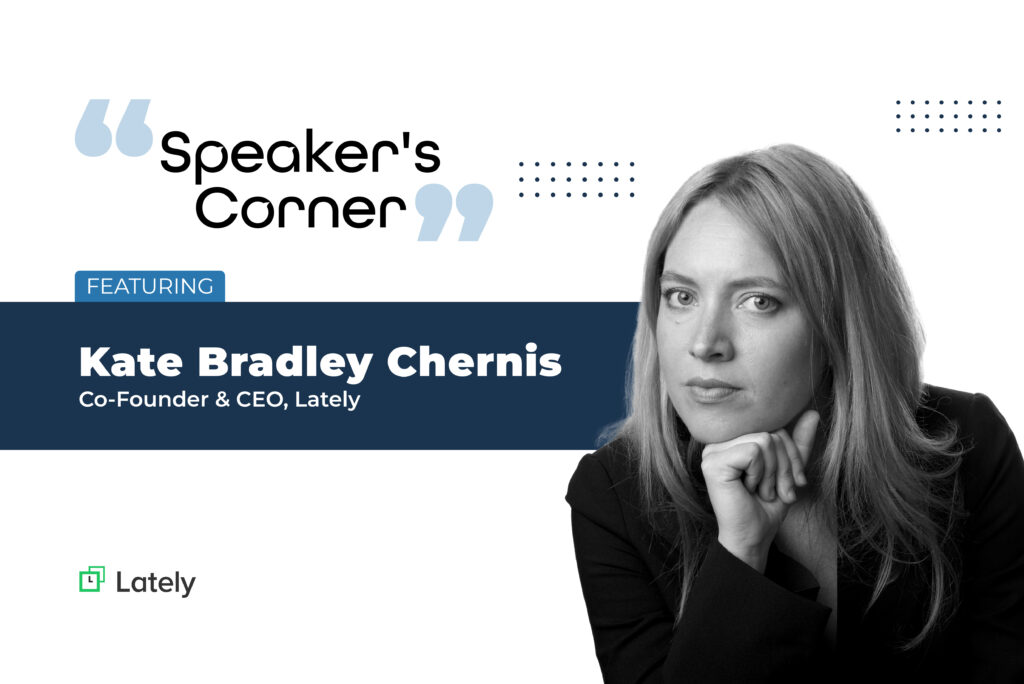
Kate Bradley Chernis is the Founder & CEO of Lately, which uses AI to generate high-engaging content in your unique brand voice that is customized to target any audience. As a former rock ‘n’ roll DJ, Kate served 20 million listeners as Music Director and on-air host at Sirius/XM. She’s also an award-winning radio producer, engineer and voice talent with 25 years of national broadcast communications, brand-building, sales and marketing expertise. What she learned in radio about the neuroscience of music helped fuel Lately’s artificial intelligence.
Before founding Lately, Kate also owned a marketing agency, which got Walmart a 130% ROI, YoY for three years. In addition, Kate appeared as a guest speaker on hundreds of sales, marketing, and entrepreneurial podcasts and has led presentations for Walmart, Ericsson, SAP, National Disability Institute, IRS, United Way Worldwide, SaaStr, SXSW, Content Marketing Institute, HubSpot, Hootsuite, Harvard University, Columbia University, NYU, and others.
In this blog, she speaks to Eventible about her incredible journey, her growth strategy Lately’s AI-powered solutions, and much more! So let’s get started.
We believe that every entrepreneur has a story to tell. What’s your story behind starting Lately? How did it all start?
Believe it or not, I used to be a rock ‘n’ roll DJ – my last radio gig was broadcasted to 20 million listeners a day for XM Satellite Radio. Alas, radio is a major boys’ club. I felt squashed, invalidated. And, of course, there was sexual harassment galore. But what really bothered me was not getting credit for my work. So, I moved to another music-related company, but it was the same thing all over again. I was miserable. Always crying. It was such a toxic situation because I hated my job and felt stuck. One day, my dad lovingly shook me by the shoulders and said: “You can’t work for other people and there’s no shame in that.” Eureka! My husband bought me Guy Kawasaki’s Art of the Start. Somewhere in the first few pages, it reads: “Don’t make a plan, just get started.” The next day, I went to a business lunch with two incredible humans who turned out to be angel investors. They gave me $50,000 to start my first company. True story!
As I was marketing that first company, someone else noticed and offered me a chunk of change to consult them on marketing. Suddenly, I was working with Walmart, United Way Worldwide, National Disability Institute, Bank of America and thousands of small and medium businesses and non-profits, all with different marketing skill sets and budgets. So, I built a spreadsheet to organize my mind, and my spreadsheet system ended up getting us 130% ROI YoY for three years. Ta-da! The idea for Lately was born.
● Tell us about your AI-powered solutions.
Lately’s AI learns which words will get you the most engagement and turns video, audio and text into dozens of social posts that contain those words. You can run any longform content thru Lately. Our AI will slice it up into dozens of high-performing social posts. Works with text, audio and video. It also, works with earned, owned or found media. Additionally, it works with podcasts, webinars, blogs and more! From text, we’ll generate dozens of social posts. From audio, we’ll generate a transcript and dozens of social posts with matching audiograms. From video, we’ll generate a transcript and dozens of posts with matching video clips.
You can run any longform content thru Lately. Our AI will slice it up into dozens of high-performing social posts. Works with text, audio and video. It also, works with earned, owned or found media. Additionally, it works with podcasts, webinars, blogs and more! From text, we’ll generate dozens of social posts.”
Kate Bradley Chernis, Co-founder & CEO, Lately
Lately’s AI gets smart by studying what messaging gets you the highest possible engagement. It learns this by processing your social media analytics data. It then compares what it learns against the best practices of millions of data points amassed from its own archives.
First, Lately’s AI learns your unique brand or individual voice. It then creates a custom writing model, just for you – and applies this writing model as it scans your long-form content for what to slice up. In some cases, it also rewrites these posts to make sure they have the greatest chance for success.
● How does Lately protect customer data?
We use AWS Shield as part of AWS Route 53 for our DDOS protection (https://aws.amazon.com/shield/), GitHub’s Dependabot for dependency security checks (https://dependabot.com/) and perform monthly internal security and privacy audits. Additionally, our AWS data centers are SOC3 compliant and we utilize the Principle of Least Privilege when accessing customer records. Moreover, all actions taken within Lately’s back-end management system is logged and all access to other internal tools is also logged within those tools.
● What challenges have you been or are constantly facing in your industry today? And how have you overcome them or what do you hope to do to overcome them in the future?
Early on, we saw that the very large companies started to have similar demands like the very small companies. This went against what most investors would ever tell you: “You can’t market to everybody.” But we discovered that, in our case, this wasn’t true.
And we kept discovering this again and again. In fact, we proved that we could market to small, medium and big enterprises the exact same way – constantly in the face of people saying, “you can’t do this.” People are people. No matter the kind of company you’re selling to. So this year, we made a crazy decision and again did something you’re not “supposed” to do. Typically, you sell upmarket and then you’re able to sell down the market, later on. Salesforce is a good example. Get your enterprise, set going and then create a self-service product.
But we realized that to secure the enterprise, we had to have self-service in place, first. And the reason is — not too different from Zoom and similar software — people want to pass our product around and collaborate with others. We needed to give them the ability to do so. The idea is that these first cohorts of users in the company become the social proof to eventually sell Lately to the CMO or CRO. This kind of bottom-up adoption was already happening for us. But it was breaking somewhere along the process. We had an enterprise product in the hands of individuals and they were like, “shit, where’s my team? I can’t use this without more help.” Or, “I need more training.”
we realized that to secure the enterprise, we had to have self-service in place, first. And the reason is — not too different from Zoom and similar software — people want to pass our product around and collaborate with others. We needed to give them the ability to do so. The idea is that these first cohorts of users in the company become the social proof to eventually sell Lately to the CMO or CRO. This kind of bottom-up adoption was already happening for us.”
Kate Bradley Chernis, Co-founder & CEO, Lately
Also, on the enterprise side, our $99/month price point was often too much – users still had to go through months of paperwork and shenanigans with the company accounting team. This prompted us to make another fundamental, not-advised switch in our strategy: ignore our MRR. Which was a big deal, as everything we had done up until that point was laser-focused on that very metric. In fact, our focus on MRR was obscuring our focus on customer retention and on KPIs that actually signaled when and where users were making progress. This was a mind-blowing “aha” for us.
The catalyst behind the insight was a guy named Mark Roberge, the former CRO of HubSpot, who took them from seed to IPO. Mark’s insight unlocked a mindset switch that permitted us to return to building what we had initially set out to build – a self-service marketing and sales product designed for any army of one to be an actual army. After all, the long tail of the self-serve, those are my people! Having been a rock n roll DJ, broadcasting to 20 million listeners for XM and elsewhere, I knew all about marketing and selling to the longtail. The key is: when you sell to businesses like they are individuals, not only do you make the sale but you make evangelists. Exponential win.
Thus we decided to more or less ignore our enterprise product. We placed a “do not fix” rule on bugs unless they were 5-alarm. And we repositioned resources, eliminating our sales team and doubling down on engineering. One of the biggest questions was: can we market the self-service product the same way we were marketing the enterprise? With no paid ads, no cold calls, and no cold emails? With just dogfooding Lately (I’ll unpack this below); is all organic? Because our enterprise product has a 98% sales conversion – not a typo. The answer is “yes.” We have a 49% conversion on my self-service product (industry-standard is 25%-33%).
● Can you share with us any one particular growth strategy or hack that’s always worked for you?
The thought is always, what can we do with the resources we have? That will have the biggest bang for the buck. Writing, for example, even for me, is hard and time-consuming. To sit down and write a blog or newsletter, I need four uninterrupted hours – nearly impossible. And I’d essentially need to crank that kind of content out daily – wildly impossible.
But, having been a rock ‘n’ roll deejay, broadcasting to 20 million listeners a day for XM Satellite Radio… I’m a killer on-air. It’s easy for me. No sweat. I don’t have to prepare for anything, I don’t even have to think about it. My biggest concern before I hop on an interview or a podcast is my hair (which is always a hopeless disaster).
Right around the beginning of COVID, I had done a few interviews, here and there. But the requests started coming in more often – I’m a great guest, I’m a woman, I’ve got a background as a rock ‘n’ roll DJ and I’ve got my hands in AI. I am in demand. That was the aha. I recognized that I could use this “earned media” the same way I was thinking about “owned media” and repurpose it through our own AI. I created a self-fueling marketing machine that costs zero dollars and almost no effort.
I recognized that I could use this “earned media” the same way I was thinking about “owned media” and repurpose it through our own AI. I created a self-fueling marketing machine that costs zero dollars and almost no effort.”
Kate Bradley Chernis, Co-founder & CEO, Lately
This was my answer to the resource question on marketing: I can certainly spend half an hour, or an hour a day, almost once a day, every day, giving a workshop, having an introspective conversation, and reaching shared audiences. To take it a step further, we not only broadcast what comes out of the AI on our own brand channels but also then syndicate it across all of our employees’ own social channels. Because I built that feature into Lately. Double dogfood!
This is the thing that so many entrepreneurs forget. If you don’t have a huge network, glom on to the others in your network. This is why the culture we have internally at Lately is so essential – not just a team, but a fandom. I built a team that’s willing to promote the team’s work. Because I can’t possibly do it by myself. Together, we’re stronger. What’s more, is that everyone on the team is a social beast. That’s their nature. They are already doing it. It’s effortless. It’s part of the DNA of how they exist in the world. I’ve learned to hire that way, having made a few mistakes in that arena. If a salesperson I was about to hire had a LinkedIn page without a custom URL, someone on our team now flags it, “dude, you know this person is not going to sing for you, what the hell are you doing?” That’s now part of how we inherently think.
We also have a Slack channel called #sharingiscaring. Every time anyone writes about us on social media in any way, we take the link and pop it in there. And the entire team is required (and wants to) to share it, retweet it, and comment on it. This is how we organically boost – an essential component of our lead generation.
In addition, our social media contractor keeps an eye out, like a hawk, on every new customer coming in on Stripe, and she finds them on LinkedIn or Twitter or whatever platform they’re on, and starts to re-share their content. We also try to participate in whatever they publish. We take links that they post, put them through Lately, and then share them with the team and ask, “hey guys, our friend, Jen McFarland was featured in an amazing book this week. Hop on. Let’s congratulate her.” We ensure they’re aware of who we are and that we’re on their team. Again… Together, we’re stronger.
It’s dogfood upon dogfood upon dogfood.
All of that together is how we get that 98% sales conversion on the enterprise side. Once we kick off promotions, we watch to see who likes, comments, and shares – as these people are warm leads because there’s some recognition or social proof around that activity they did. Then by the time we get them to a demo, they’re essentially hot. As I mentioned above, the big question was, will this work on the self-service side? Because obviously there’s no demo there. You already know the answer :-).
● What does a typical day for you look like? How do you strike a balance between work and life?
I don’t. I don’t believe in a balance between work and life. Work is life. Life is work. If that’s not the case, I need a new job :-).
● How was your experience at Content Marketing World 2022? What was your biggest takeaway?
Myself – naturally LOL. I put on a good show ;-): https://schedule.contentmarketingworld.com/session/the-copywriting-rules-you-wish-you-had-in-college/885919
● As a leader, what are the factors, both professional and personal, that drive you? What keeps you going?
The drivers? Fear. Self-doubt. My teammates. Vindication. What keeps me going? Eye cream. Meditation. Tequila.
● As an entrepreneur, what’s the one thing you want to share with other women entrepreneurs?
Don’t be so nice.
● This year we are seeing the comeback of many in-person events. What is your take on in-person events? Do you prefer them over hybrid or virtual?
If I never had to fly on a plane again I would say yes to in-person events all day.
● Eventible.com is a review platform catering to B2B events. Given how review-driven our lives have become today, do you think reviews will bring in a level of transparency to the events industry? Would you rely on event reviews from other speakers if you had to make a speaking decision?
Love it. Conferences, in particular, have gotten complacent. Same speakers. Same topics. Attendance is way down, across the board. And that’s not just because of COVID. People are bored. This industry is ripe for disruption.




Comments are closed.